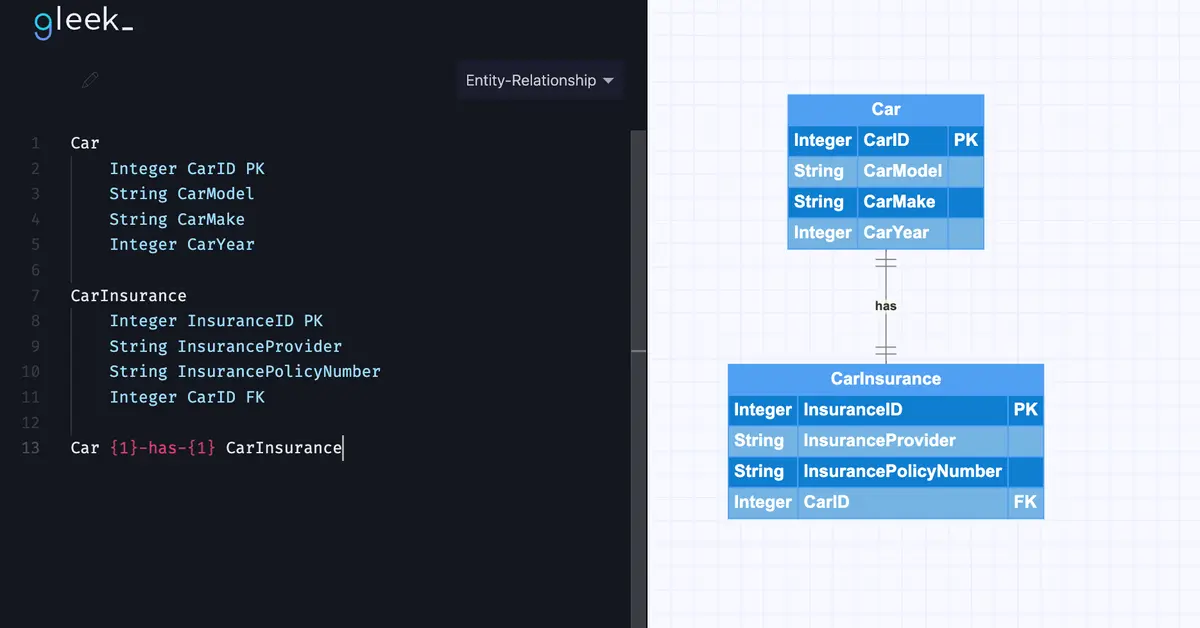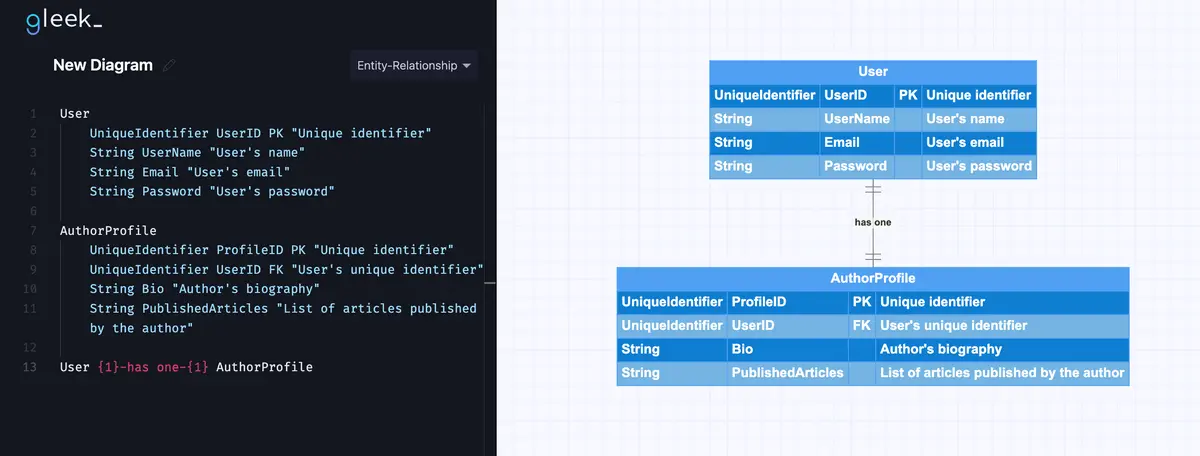Entity Relationship Diagrams (ERDs) are essential tools in database design, serving as visual blueprints for mapping out the structure of database systems. They illustrate entities—real-world objects or concepts with data—and the relationships between these entities, providing a clear picture of how data is interconnected within the system.
Introduction to ERDs
In ERD diagrams, entities are represented as rectangles, while the relationships among them are depicted as lines. This visualization helps in understanding the organization of data and guides the efficient design and optimization of the database before it's built, minimizing issues like redundancy and inconsistency.
ERDs are not only useful for database professionals but also make complex systems more comprehensible to non-technical stakeholders by offering a simplified depiction of database architecture. Understanding ERDs is critical for anyone involved in the creation or management of a database, as they ensure the development of organized, reliable database systems.
Check our latest article on How to show multiplicity in an ER diagram.
Understanding 1 to 1 Relationships in ERDs
A one-to-one (1:1) relationship in ERDs is a fundamental concept that defines how each entity within a database is uniquely associated with another entity. This type of relationship ensures that for every entry or instance of one entity, there is precisely one corresponding entry or instance in another entity, and vice versa.
Make your own ER diagram in Gleek.
To put this into perspective, consider the real-world example of a person and their passport. In a database modeling this scenario, each person entity would have a direct and exclusive relationship with a single passport entity. This means one person cannot possess multiple passports within this context, and similarly, each passport is linked to one, and only one, person. The 1:1 relationship is meticulously maintained to ensure data integrity and consistency, reflecting the unique connection between the two entities in the real world.
In an ERD, a one-to-one relationship is visually represented by connecting the entities with a line. Markings or symbols near the ends of these lines often indicate the nature of the relationship, with specific notation denoting the 1:1 association. This visual cue helps database designers and users understand the structure and limitations of the database, ensuring that the data model accurately represents the intended relationships between entities.
Learn about One-to-Many and Many-to-many relationships in Databases.
Understanding one-to-one relationships is key to effectively designing and interpreting ERDs. It allows for a clear representation of instances where unique connections between entities exist, facilitating precise data modeling and retrieval in scenarios where exclusivity and direct correspondence are required.
Representing 1 to 1 Relationships in ERDs
In ERDs, representing a 1:1 relationship involves specific visual notations that clearly indicate the nature of these exclusive connections between entities. The Gleek app, known for its intuitive approach to ERD creation, utilizes two primary notations to delineate 1:1 relationships:
{1}--{1} Notation: This denotes a strict one and only one relationship on both sides. It signifies that for every instance of an entity on one side, there is exactly one corresponding instance of the connected entity on the other side, with no exceptions. This type of notation is used when both entities involved have a mandatory presence in the relationship, reflecting a scenario where each entity is essential for the other's existence.
{1}--{01} Notation: This representation indicates a one and only one notation on one side of the relationship and a zero or one notation on the other side. This variation implies that while one entity must always be associated with exactly one instance of the other, the reverse does not necessarily hold true. In other words, an instance of the entity on the "01" side may or may not exist for every instance of the entity on the "1" side. This notation accommodates scenarios where the relationship is indispensable from one perspective but optional from the other.
Beyond visual notations, key constraints play a vital role in enforcing and representing 1:1 relationships within databases. Primary keys and foreign keys are instrumental in this regard:
Primary Key: A unique identifier for each record in a table, ensuring that each entry is distinct.
Foreign Key: A field (or collection of fields) in one table that uniquely identifies a row of another table.
Read on the differences between Primary and Foreign keys in our comprehensive guide.
In a 1:1 relationship, the foreign key in one table corresponds to the primary key of the other, and typically, unique constraints are applied to the foreign key to enforce exclusivity. This mechanism ensures that each entity on one side of the relationship can only be linked to one unique entity on the other side, perfectly aligning with the {1}--{1} and {1}--{01} notations.
Make your own ER diagram in Gleek.
Through these visual cues and database constraints, ERDs effectively communicate the specific dynamics of 1:1 relationships, allowing for accurate database design and integrity maintenance.
Best Practices for Designing 1 to 1 Relationships
When it comes to database design, the implementation of one-to-one (1:1) relationships can significantly impact both the efficiency and integrity of your database. While 1:1 relationships are less common than other types of relationships, they are crucial in certain scenarios to maintain data accuracy and ensure coherent design. Here are some best practices for when and how to implement a 1:1 relationship in your database design:
When to Implement 1 to 1 Relationships:
Exclusive Data Segregation: Use a 1:1 relationship when you need to segregate sensitive or exclusive data into a separate table. For instance, splitting user information between a
Userstable and aUser_Detailstable where each user has unique, sensitive details that warrant separation.Optional Information: When dealing with optional data that only a subset of the primary entity possesses. For example, a
Carentity and aCar_Insuranceentity could be linked via a 1:1 relationship, as not all cars may have associated insurance details.
Performance Optimization: Large datasets can benefit from 1:1 relationships by distributing columns into separate tables, improving query performance and facilitating easier maintenance.
Design Considerations for Efficiency and Integrity:
Careful Planning: Thoroughly analyze your data model to ensure that a one-to-one relationship is the best approach. Overusing 1:1 relationships can lead to unnecessary complexity and inefficiency.
Enforce Constraints: Use primary and foreign keys effectively to enforce the exclusivity of the relationship. Applying unique constraints on foreign keys ensures that the relationship remains strictly one-to-one.
Data Redundancy: Avoid redundancy by not duplicating data across entities linked by a 1:1 relationship. Ensure each piece of information has a single, definitive source within the database.
Example Scenario:
Consider a scenario involving an online platform where users can publish articles. Here, a User table contains general information about the users, and a separate Author_Profile table stores detailed information available only for users who are authors. This setup leverages a 1:1 relationship to efficiently separate general user data from specific author data, ensuring data integrity and optimizing access to author-related information.

Make your own ER diagram in Gleek.
The Importance of Efficient Database Architecture:
Designing an efficient database architecture requires a strategic approach, especially when implementing 1:1 relationships. Such relationships should be used judiciously to avoid unnecessary fragmentation of the database. Clear, practical reasons should drive every decision to separate data into distinct tables with a 1:1 relationship—security, performance optimization, or data organization.
For those looking to design or refine their database structures with precision, using a tool like the Gleek app can significantly streamline the process. Gleek offers an intuitive interface for creating ERDs, making it easier to visualize and implement effective 1:1 relationships among your data entities. Start using the Gleek app today to enhance your database design and ensure your ERDs are efficiently structured and easy to understand.
By adhering to these best practices, database designers and architects can ensure that their use of 1:1 relationships contributes positively to the database's overall structure and that it serves its intended purposes with optimal efficiency and integrity.
Related posts
All about ER model cardinality with examples
Derived Attributes in ER diagrams: A comprehensive exploration
ER diagram for an E-commerce website with Gleek's AI chat
What is an associative entity in an ERD?
Primary keys vs. unique keys: Fundamental differences
Relational schema vs. ER diagrams: A detailed comparison
Guide to entity-relationship diagram notations & symbols
Composite and other attributes in the entity-relationship model
